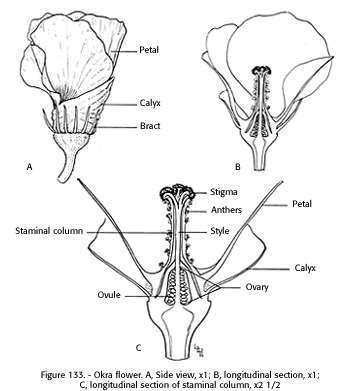OKRA
Hibiscus esculentus L., family MalvaceaeOkra is primarily a southern vegetable garden plant, grown for its immature pods, which are consumed when cooked either alone or in combination with other foods (fig. 132). Hawthorn and Pollard (1954*) showed 475 acres devoted to seed production in 1951. Miller (1949) indicated yields of 1,000 to 1,500 pounds of seed per acre. At a planting rate of 8 pounds of seed per acre (Knott 1949), this 475 acres should supply sufficient seed to plant 60,000 to 70,000 acres of okra.
[gfx] FIGURE 132. - Okra plant with pods.
Plant:
Okra is an upright annual, 3 to 6 feet tall, with a main stem and several branches. It is susceptible to frost but can tolerate hot weather and will grow anywhere cotton will grow. It is usually planted in 3- to 3 1/2 foot rows, the plants about 1 foot apart in the row, after all danger of frost is past. The pointed angular, ribbed or round pods, 3 to 5 inches long, are made up of five to nine carpers, each carper capable of producing about 30 seeds. The okra leaf is similar to that of cotton, 4 to 12 inches across. There are numerous cultivars.
Inflorescence:
The single showy okra flower, as much as 2 inches across, resembles the cotton flower, with its wide corolla usually made up of five yellow to cream-colored petals (fig. 133). The erect sexual parts consist of a five to nine part style, each part with a capitate stigma, surrounded by the staminal tube bearing numerous filaments (Purewal and Randhawa 1947, Purseglove 1 968*). The flower opens shortly after sunrise and remains open until about noon. The petals wilt in the afternoon and usually fall the following day. The anthers dehisce 15 to 20 minutes after the flower opens, and some of the pollen comes in contact with the stigma.
[gfx] FIGURE 133.- Okra flower. A, Side view, x 1; B, longitudinal section, x 1; C, longitudinal section of staminal column, x 2 1/2.

Pollination Requirements:
The okra pollen grain is large with many pores, and every pore is a potential tube source; therefore, many tubes can develop from one pollen grain (Purewal and Randhawa 1947). Okra is self-fertile, and, when the anthers come in contact with the stigmas, self-pollination may result; however, cross-pollination also occurs. Purewal and Randhawa (1947) reported that 100 percent of both bagged and open flowers set fruit, but they did not indicate the degree of seed setting in the two treatments. They also reported 4 to 18 percent cross-pollination.
If the anthers deposit an adequate number of pollen grains on the stigmas to fertilize all of the ovules, and outside agency is not needed to transfer the pollen. However, if an inadequate amount of pollen contacts the stigmas leading to each carper, and some of the ovules are not fertilized, that area around the unfertilized ovule is less well developed.
Pollinators:
Okra is not wind pollinated. It is freely visited by honey bees and bumble bees, but the value of insect pollinator visitation is unknown. Studies should be made of seed production and pod development of bagged, selfed, and cross-pollinated okra flowers to clarify the pollination requirements and needs for pollinators.
Pollination Recommendations and Practices:
None.
LITERATURE CITED:
KNOTT. J. E.
1949. VEGETABLE GROWING. 314 pp. Lea and Febiger, Philadelphia.MILLER, J. C.
1949. GROWING OKRA SEED FOR OIL. Chemurg. Digest 8(5): 22-24.PUREWAL, S. S., and RHANDHAWA, G. E.
1947. STUDIES IN HIBISCUS ESCULENTUS (LADYFINGER) (OKRA) I. CHROMOSOME AND POLLEN STUDIES. Indian Jour. Agr. Sci. 17: 129-136.
